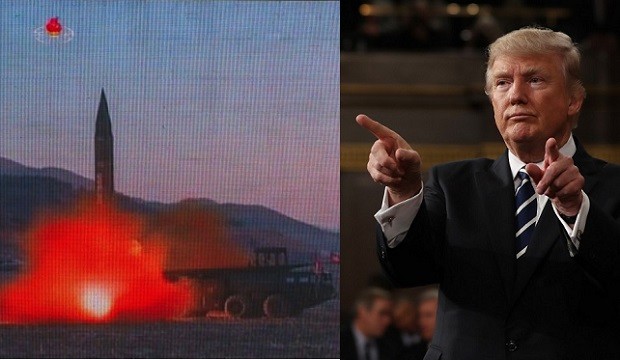Missile tests put North Korea on Trump’s front burner

US President Donald Trump (right) is facing his biggest foreign policy challenge after North Korea fired four ballistic missile into seas covered by Japan’s exclusive economic zone. At left, news footage shows a missile launch. Nuclear-armed North Korea said its missile launches were training for a strike on US bases in Japan, as global condemnation of the regime swelled. AFP
WASHINGTON, United States — President Donald Trump is facing his biggest foreign policy challenge yet after North Korea fired a ballistic missile salvo in a supposed training run for an attack on US bases in Japan.
Pyongyang blasted at least four missiles across the ocean toward its eastern neighbor on Monday, and three of the rockets splashed down into waters within Japan’s Exclusive Economic Zone.
The latest tests mark the end of what had been a quiet spell in North Korean weapons testing — with little activity since Trump’s election in November — and propels the long-simmering issue to the White House front burner.
Trump in January had tweeted that North Korea’s stated goal of building a long-range nuclear missile to hit the US mainland “won’t happen” — but he never provided details.
After North Korea said the missile launches were training for a strike on US bases in Japan, where about 50,000 American troops are stationed, Japanese Prime Minister Shinzo Abe and Trump spoke by phone and warned the threat from North Korea had “entered a new stage.”
Article continues after this advertisementTrump must now define what exactly that means, and what America’s response will be.
Article continues after this advertisement“We are in a very tenuous situation with not a lot of leverage, not a lot of initiative in terms of negotiations,” a senior defense official told reporters recently.
“So as you might imagine we are preparing for contingency operations to the degree we need to,” the official said.
Secretary of State Rex Tillerson is traveling to South Korea, Japan and China next week, his first visit to the region.
He will discuss “strategic coordination to address the advancing nuclear and missile threat from North Korea,” State Department acting spokesman Mark Toner said.
“Given North Korea’s continuing provocative behavior and actions, the US is actively engaged with its partners and allies in the region to address the threat posed,” he added.
Anti-missile technologies
Further ramping up regional tensions is the deployment of an American anti-ballistic missile battery called THAAD, a successor to the Patriot system.
China is furious about the move, even though the interceptors can only be used for defense and cannot directly engage Chinese missiles.
Beijing worries THAAD’s radar system will give the United States precision tracking capabilities of China’s own missiles, and weaken its deterrence against America.
“This is somewhat exaggerated as a threat but the full capabilities of the THAAD system are classified so it can’t be entirely discounted,” said John Schilling, an aerospace expert and consultant at the 38 North program of the US-Korea Institute at Johns Hopkins University.
Experts say Pyongyang’s simultaneous firing of at least four missiles is possibly an attempt to overcome anti-missile systems by overwhelming them.
The Patriot system could supposedly stop up to 16 missiles at a time, and THAAD is thought to only build on that number. But trying to stop a missile with another missile is far from infallible.
North Korea analyst Joseph Bermudez said Pyongyang potentially has enough mobile launchers to fire at least 36 ballistic missiles of various types at the same time.
Monday’s missiles were either enhanced extended-range Scuds or medium-range No Dong ballistic missiles that date back to the 1990s and can’t reach mainland America.
Fresh start
Privately, the North Koreans had been sending signals they wanted a fresh start with the Trump administration, said Joel Wit, a co-founder of the 38 North program.
But the start of US military drills with Seoul this week ended that chapter.
“That posture wouldn’t last forever and the US-(South Korea) joint exercises that are taking place now were signaled as possibly ending that quiet period,” Wit said.
Anthony Ruggiero, a North Korea expert from the Foundation for Defense of Democracies, said the deployment of the THAAD system is an important development, but it doesn’t do anything to address North Korea’s ballistic missile program.
“To roll it back, we need to be sanctioning more North Korean entities outside North Korea,” he said, suggesting that the Trump administration should more aggressively target international banks that do business with North Korea.
“There should be no reason why legitimate, reputable foreign banks need… to conduct business with North Korean banks,” he said.
The Obama administration slapped heavy sanctions on Pyongyang businesses, agencies and individuals, but most are confined to North Korea so the impact has been limited.
Ruggiero also noted that although Monday’s missiles weren’t particularly sophisticated, the simultaneous firing towards Japan marked an aggressive turn.
On leaving the White House, Obama warned Trump the threats from Pyongyang would likely be the most urgent he would face.
The Obama administration had implemented a slew of sanctions, backed by numerous UN resolutions, while maintaining openness to dialogue.
The New York Times reported that the United States also attempted cyber attacks designed to disrupt missile launches. CBB